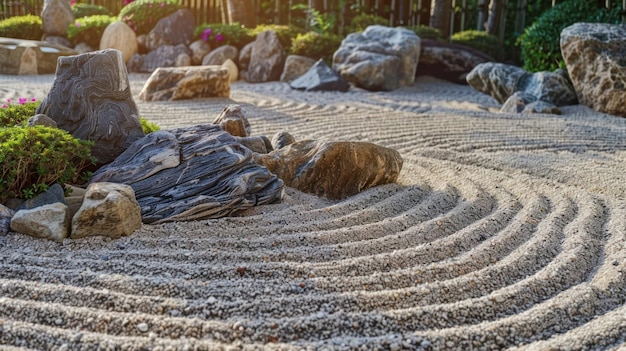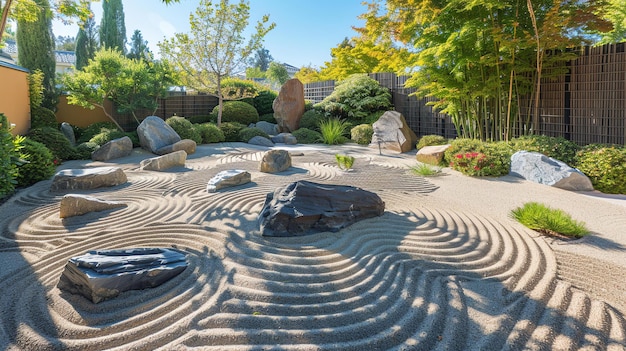When I first stumbled upon the idea of a Zen garden, I wasn’t entirely sure what it would bring to my life. I had heard about their calming effects and their role in promoting mindfulness, but could a small, carefully designed garden really make such a difference? Fast forward to now, and I can wholeheartedly say that embracing Zen garden design has transformed not just my backyard, but my daily mindset.
A Zen garden is more than just a space with sand, stones, and plants. It’s a thoughtful practice in simplicity, balance, and relaxation. So, if you’re curious about creating your own serene sanctuary, you’ve come to the right place. In this guide, I’m going to take you through everything you need to know to design your very own Zen garden—right in your backyard or even on a small balcony.
Let’s dive in and explore how you can bring calm into your life with the art of Zen garden design.
What Exactly is Zen Garden Design?

Before diving into the ‘how’ of it all, let’s take a moment to understand what Zen garden design truly means. Originating from Japanese culture, a Zen garden, also known as a Japanese rock garden or Karesansui, is traditionally designed with minimalist features. It typically includes elements like rocks, sand or gravel, and sometimes, plants. These components are arranged in ways that represent natural landscapes and embody the principles of harmony, balance, and tranquillity.
You don’t need a vast garden to create a Zen space—one of the best things about Zen garden design is its adaptability. Whether you have a sprawling backyard or a small balcony, you can still craft a space that brings peace to your daily life.
Why Create a Zen Garden?
If you’re wondering whether this is a good idea for your space, here are a few reasons why I believe Zen gardens are worth considering:
- Mental Clarity: The simplicity and order in a Zen garden are designed to help clear your mind, promoting mindfulness and relaxation.
- Stress Relief: The act of maintaining and interacting with your Zen garden, like raking the sand or placing stones, has a calming effect on the mind and body.
- Beautiful Aesthetic: Zen gardens can create a visually pleasing focal point, transforming any space into a serene retreat.
- Minimal Maintenance: Unlike traditional gardens that require constant tending, a Zen garden is much easier to maintain once it’s set up.
When I first created mine, it became a place where I could retreat after a long day, grounding myself and clearing my head in ways I never expected.
Key Elements of Zen Garden Design
When designing a Zen garden, there are a few essential elements that should be incorporated to maintain the right balance and aesthetic. Here’s a breakdown of the core components:
1. Rocks and Stones
Rocks and stones are the backbone of any Zen garden. In traditional Zen gardens, they represent mountains, islands, or other natural features. In my own garden, I love using smooth stones for their calming effect. When selecting rocks, choose ones that vary in size and texture to create visual interest. Large stones can be placed as focal points, while smaller ones can form paths or be used to symbolise flowing water.
2. Sand or Gravel
Sand or gravel is used to represent water in Zen garden design. The raked patterns that we create in the sand are said to mimic the ripples in water, adding to the sense of movement and fluidity in an otherwise still space. I personally enjoy the quiet time spent raking the sand—it’s a meditative practice that’s surprisingly therapeutic. You can choose between white, beige, or even darker tones of sand to match the overall aesthetic of your garden.
3. Plants (Optional)
Though plants aren’t a must in a Zen garden, adding a few can bring an extra layer of life to your space. Simple, low-maintenance plants like bonsai trees, bamboo, or moss can provide a natural contrast to the otherwise minimal design. I’ve found that having a single bonsai or a few scattered ferns brings a soft touch of nature without overwhelming the serenity of the garden.
4. Wooden Features and Pathways
Wooden features like bamboo fencing or simple wooden pathways can complement the rest of the elements in your Zen garden. These features help define the space and can guide you through the garden. I love adding small wooden bridges or simple stepping stones that give the garden a sense of depth and purpose.
How to Design Your Own Zen Garden
Now that you understand the basic elements let’s walk through the steps to create your own Zen garden.
Step 1: Choose Your Space
You don’t need an expansive garden to design a Zen garden. In fact, many people create small Zen spaces on their balconies or even inside their homes. Choose a space that feels right to you—somewhere you can retreat to for moments of peace. If you’re working with a small area, consider using a container garden or even a tabletop Zen garden.
Step 2: Select Your Materials
Once you’ve identified your space, it’s time to choose your materials. You’ll need:
- Rocks (both large and small)
- Sand or gravel (white sand works well, but you can opt for a darker hue)
- Plants (optional, but something simple like moss, bamboo, or a bonsai tree can work well)
- Tools for raking (a small rake for the sand is all you really need)
Step 3: Plan Your Layout
Start by arranging your larger rocks in a natural formation, mimicking the look of islands or mountains. Then, use smaller stones and gravel to create pathways or borders. Place your plants in the background or along the edges—remember, the idea is to keep things simple and uncluttered.
One mistake I made early on was over-complicating the design with too many elements. The beauty of Zen garden design is in its simplicity, so focus on a few carefully chosen features rather than trying to include everything.
Step 4: Rake and Maintain
One of the most enjoyable aspects of Zen garden design is the act of raking the sand or gravel. You can create beautiful swirling patterns, allowing yourself to be present in the moment. This is a form of active meditation. Over time, I found that the repetitive motion of raking helps to clear my mind and keeps me grounded.
Step 5: Enjoy Your Space
Once everything is set up, take a moment to step back and appreciate the serenity you’ve created. Use your Zen garden as a place to pause, reflect, and recharge. Whether you spend five minutes or an hour there, your garden will become a peaceful haven.
Final Thoughts

If you want to bring more peace, balance, and mindfulness into your life, Zen garden design is an amazing way to do so. It’s an accessible, low-maintenance approach to gardening that can provide you with an oasis of calm, no matter your living situation. Whether you choose to add plants or keep it minimalist with rocks and sand, your Zen garden will offer you a quiet space to reconnect with yourself and nature.
Have you ever considered creating a Zen garden? I’d love to hear about your experience or any questions you might have. Share your thoughts in the comments below!
Also, if you found this guide helpful, don’t forget to share it with your friends looking for some serenity in their lives.

